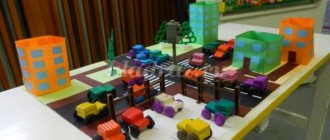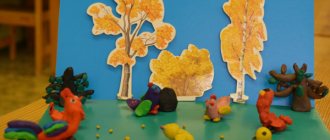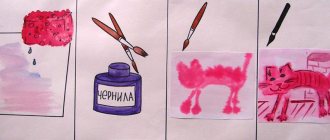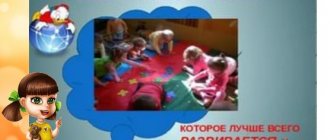Card index of games for artistic and aesthetic development in the middle group.
Progress of the game:
Objects are partially drawn in the pictures (bunny, Christmas tree.). You need to recognize the subject, fill in the parts that are missing, and color it.
“Let’s prepare the table for the holiday”
Target:
develop the ability to select shades of primary colors and create a beautiful color scheme.
Progress of the game:
In front of the children are cut out paper tablecloths of different colors (red, yellow, blue, green) and 4 - 5 shades of paper tableware of each color. The task is to match the main color to its shades. Select tableware so that the color matches the tablecloth.
Board game "Domino"
Target:
To consolidate children's knowledge about arts and crafts - toys; the ability to find the right toy and justify your choice. To consolidate knowledge about the manufacture of folk toys and the features of each. Cultivate a love of beauty.
“Paint a scarf for mom”
Target:
To consolidate children's knowledge about the art of the Russian shawl. To develop children's aesthetic taste, to teach them how to make simple patterns from various decorative elements (flowers, leaves, buds, twigs, etc.), and the ability to select the color scheme of a pattern.
"Art Crafts"
Target
: To consolidate children’s knowledge about folk arts and crafts; find the desired trade among others and justify your choice.
"Collect a Gzhel rose"
Target
: To consolidate children’s ability to compose a Gzhel rose using appliqué based on Gzhel painting, to maintain interest in Gzhel craft.
"Collect a matryoshka doll"
Target:
To consolidate children's knowledge about the folk toy - matryoshka; the ability to assemble a nesting doll from parts using the mosaic method. Highlight decoration elements. To cultivate respect and love for folk art.
“Complete the pattern”
Target:
The game is aimed at developing children's attention and memory, developing a sense of symmetry followed by coloring.
Progress of the game:
The beginning of the pattern is drawn on a piece of paper. Children need to extend the pattern further and color it.
“Find friends among the colors”
Target:
discover the level of children’s knowledge in choosing paint that matches the color of the object; draw in color
Progress of the game:
Silhouettes of objects are drawn on sheets of paper. The teacher gives the task to find “friends” of yellow, green, blue, and red colors among the objects. Children find objects that match a certain color and color them.
“Make a still life”
Target:
improve compositional skills, the ability to create a composition on a specific topic (still life), highlight the main thing, establish a connection by arranging the image in space.
Progress of the game:
The envelope contains images of various vegetables, fruits, as well as various vases, plates, dishes, and baskets. Children need to choose objects and create their own still life.
Abstract of OD on artistic and aesthetic development for children of the middle group. Snowflake
Summary of educational activities on artistic and aesthetic development in the middle group “Fairytale Snowflake”
Purpose: introducing children to an unconventional technique of drawing, using a wet sheet. Tasks. Educational: 1. improve the skills of non-traditional depiction of an object (with cotton swabs) (educational field “Artistic and Aesthetic Development”); 2. encourage attempts to share impressions with the teacher and other children (educational area “Speech development”, “Social and communicative development”). Developmental: 1.develop the ability to convey specific images of objects in a drawing (educational field “Artistic and Aesthetic Development”); 2. develop independence and creativity (educational field “Artistic and Aesthetic Development”); 3. continue to develop an interest in fiction (educational area “Reading fiction”). Educational: to cultivate friendly relationships between children (educational area “Social and communicative development”). Preliminary work: observations of seasonal changes in nature in winter, conversations about the characteristic signs of winter, reading poems about winter, looking at illustrations about winter. Materials: tinted sheets of paper for each child, white gouache, cotton swabs, wet wipes for hands, sponges, glasses of water, plates, audio recording: “The Seasons” by P.I. Tchaikovsky. Progress of educational activities. The teacher is part of the group with the children: Hello, my dears: Both small and large!
I see how you have grown, how good you are! I am glad to see you so beautiful, kind, and in a good mood!
We will spend this day together. May it bring you joy and many new interesting experiences. Let's make each other happy! Children, do you like fairy tales? Children. Yes! Educator. Would you like me to tell you a fairy tale? But you have to guess what this fairy tale is about. Stars are falling from the sky and will fall on the fields. Let the Black Earth hide under them. Many, many stars, thin as glass; The stars are cold, but the earth is warm.
(Snowflakes) Yes, this is a fairy tale about a snowflake, and it was written by a girl, Sofia Linovitskaya, from the city of Kaliningrad. Children sit on chairs in front of a laptop. As the teacher tells the story, the illustrations change on the screen and calm music plays. “Once upon a time there was a little white snowflake beauty. She was born in the sky and her mother was a large, clumsy snow cloud, and there were no number of snowflake sisters.
Snowflake could sit on the edge of a cloud for hours and look at the ground with curiosity, but she didn’t want to fall at all, because she had never flown and didn’t know how to do it, and everything unknown scares. In addition, she did not want to part with her mother like a cloud, because for her the harsh cold snow cloud was the most affectionate and dear.

But one day a gust of angry northern wind picked up a light snowflake, it could not resist and flew down. And now she is already on earth. She was lucky enough to land in the cozy courtyard of a multi-story building. She calmed down, feeling at home in this hospitable courtyard, and fell asleep sweetly.
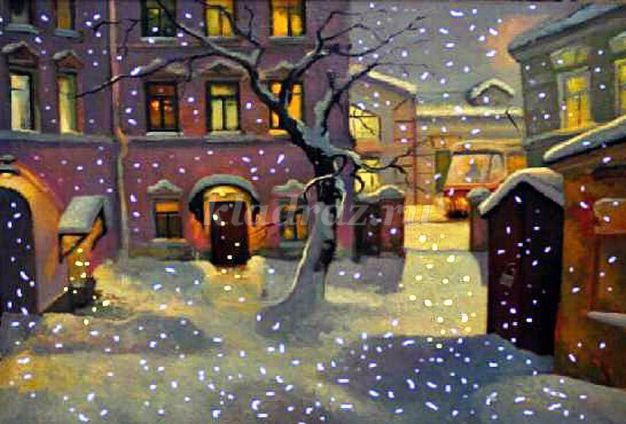
In the morning she was awakened by loud screams and ringing laughter. She opened her eyes, and there was such joy and fun all around! The children from the house near which the snowflake fell were happy about the first snow that had fallen overnight and ran out into the street. In the yard they played snowballs, sledded, made a snow woman and simply fell into the snowdrifts with a running start. Snowflake gladly took part in all the children's fun.

A snowflake lived all winter in a hospitable courtyard. She finally found out why snowflakes fall from the sky: to give a good mood and joy to children and adults, to decorate the streets of cities, dressing them in snow-white clothes, and even to warm the earth! Yes Yes! Under the cold snow, as if under a warm blanket, grass, insects and even some animals dozed in anticipation of spring. In the spring, with the first warm rays of the sun, the snowflake turned into a transparent water droplet and flew away into the sky, only to return to earth again in winter as a sparkling snow-white snowflake.”
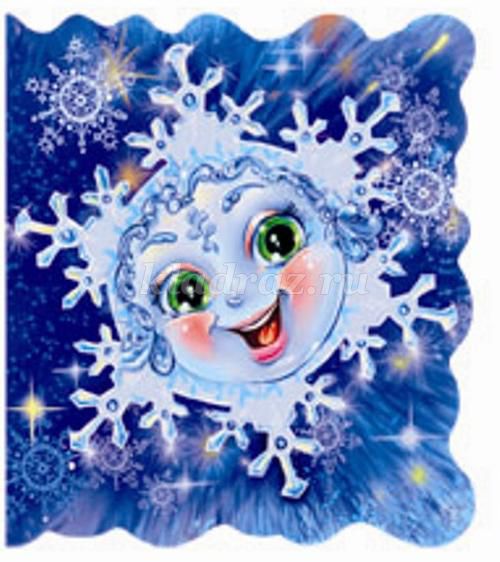
Children. Yes! Educator. Do you want to turn into snowflakes? Children . Yes! Educator. Then put your hands on your belt and say the magic words: “Turn right, turn left and turn into a snowflake!” Imitation exercise “Snowflakes” (emancipation, emotional release). Oh, snowflakes are flying and flying, (Children are running in all directions) Snow-white fluffs, This winter-winter has taken up its sleeves. (Smooth hand movements left and right) All the snowflakes began to spin (Spin in place) And lowered them to the ground. (Squat). Educator. Now let's turn into children again. Who you are? Children. Children. Educator. Many adults and even children forget after some time what they saw or did. For example, forget this fairy tale. What can you do to not forget this one? Children. (Children's answers.) Educator. You can also draw a picture. When you look at him, you will remember this fairy tale. Do you agree? Children. Yes. Educator. To make the drawing unusual, I suggest drawing it using an unconventional technique, on a wet sheet. Now I will tell you and show you how to do it. Take a sponge and wet a sheet of paper.
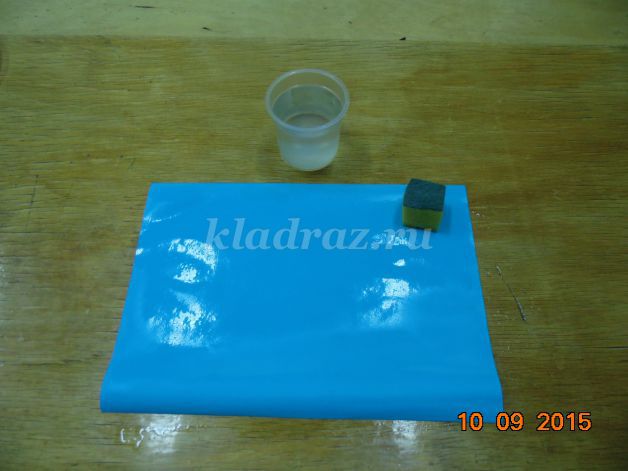
Then, using a cotton swab, draw a line across the wet sheet from top to bottom to make a straight line.
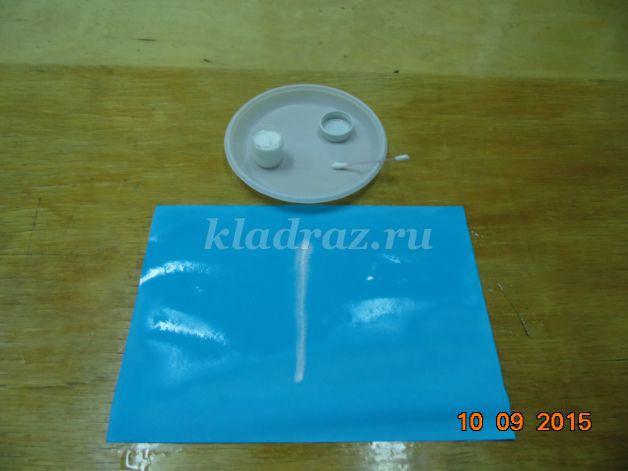
Then draw from the upper left corner to the middle, and from the middle down.
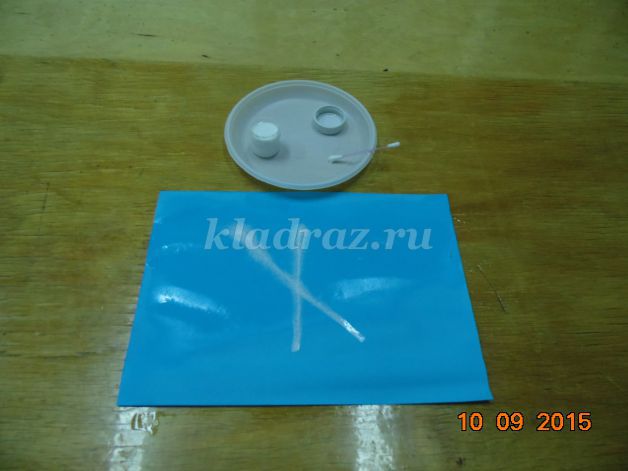
Also from the upper right corner to the middle and down.
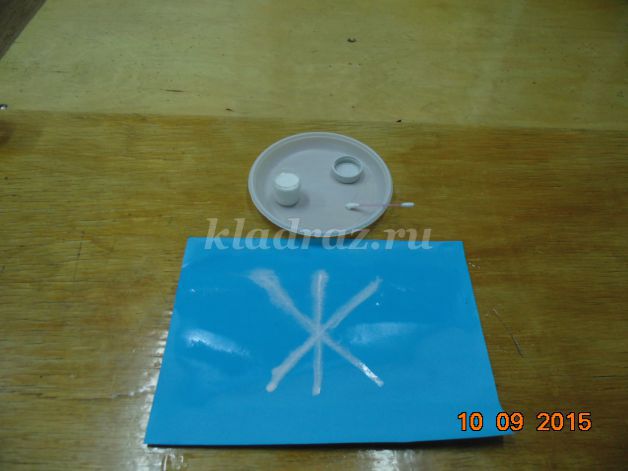
If you have time, draw short rays on the main rays. You need to draw with short strokes from top to bottom.
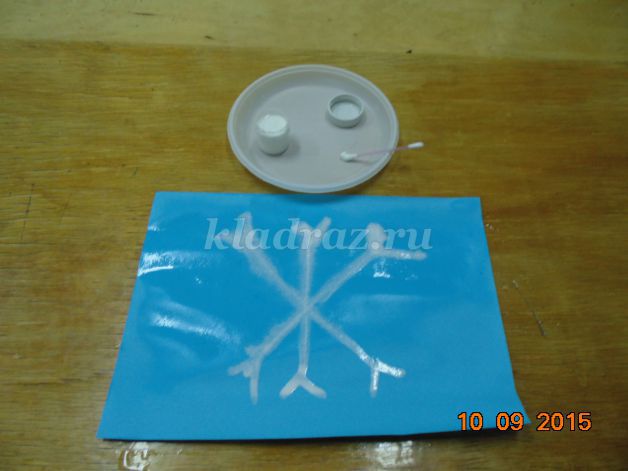
A sponge means foam rubber, clenching the sponge into a fist, and he is capricious. It can quickly absorb alternating transmission from hand to hand in rhythm And it gets darker and heavier. verse. But we get the desired drawing - very light and airy. Independent work of children. When the children are finished, they place their work on the easel.

Reflection. Educator. What did you do today? (drew snowflakes). How did you draw snowflakes? (on a wet sheet). What did you use instead of a brush? (cotton buds). What can you say about snowflakes? (beautiful, airy, light...). Why did they draw snowflakes? (so as not to forget the fairy tale). Thank you guys for keeping me company. What's your mood? - Wow! (show thumb). Let's give our good mood to others. (Children blow the mood off their palms).
We recommend watching:
Synopsis of preschool education on speech artistic and aesthetic development in the middle group of kindergarten Synopsis of educational activities on the development of coherent speech for children of the middle group “Winter”. Summary of educational activities in the middle group of a kindergarten using ICT Summary of educational activities in the middle group of a kindergarten: Let's help the birds
Similar articles:
Lesson in the middle group “Winter clothes”
Observation of the work of a janitor in winter in the middle group
Lesson on the topic: New Year in kindergarten for children of senior preschool age
Long-term planning of artistic and creative activities in the middle group
Lukina Tatyana Nikolaevna
Long-term planning of artistic and creative activities in the middle group
In the process of working on environmental topics, I used the problem of children's creativity and aesthetic development of children when introducing children to the nature of Kuban. Nature is an inexhaustible source of spiritual enrichment for children. Our Kuban is beautiful at all times of the year. On walks I pay attention to the fact that the color of each season is different and the reflections are reflected in children's creativity.
Target
classes in visual arts : the use of ideas about the diversity of signs and phenomena of the natural world in enriching the artistic concept and creative realization of the child’s artistic skills . To cultivate love for one’s native land, to convey the beauty of its nature in one’s creative works.
During the observation process, software tasks are solved:
Develop the ability to analyze and identify signs of natural phenomena and objects.
Learn to compare and find distinctive features in terms of sensory features.
Develop the ability to note the presence of warm and cold colors and shades in nature in the process of observation.
Introduce figurative comparisons into the observation process that form an artistic concept .
In the process of creativity, software tasks are solved:
Create an emotional mood for artistic activity .
Encourage children to independently convey images using available means of expression .
To promote the development of visual and artistic creativity , imagination, and thinking in children through non-traditional techniques and materials.
Create conditions for each child to complete the drawing.
Winter:
December:
1. Topic: “Conifer sisters”
.
(Various techniques for drawing spruce)
.
2. Topic: “They arrived, they arrived, the flock was met by snowstorms”
.
(Drawing tits on a rowan branch)
.
3. Topic: “New Year’s Guest”
.
(Christmas tree in festive decoration)
.
4. Topic: “Father Frost’s footprints in the forest in the snow”
. L. V. Kompantseva.
January:
1. Topic: “It’s winter – it’s white all around”
.
(Winter in the city)
.
2. Topic: “Snowflakes - stars”
(Drawing on dark paper)
.
3. Topic: “Birds at the feeder”
.
(Collective)
.
4. Topic: “White birch tree under my window...”
.
(Technique of painting with watercolors and wax)
.
February:
1. Topic: “Footprints in the snow”
.
(Printing)
.
2. Topic: “My friend – Snowman”
.
(On a toned background)
.
3. Topic: “Drawing a blizzard, blizzard”
. (Salt on a dark table surface, or swirls on tinted paper).
4.Theme: “Carnation for Dad”
.
(Holiday card)
.
Spring.
March:
1. Topic: “Snowdrop on a thawed patch”
.
(Using stained glass technique)
.
2. Topic: “Icicles are crying”
.
(Drops)
.
3.Theme: “Radiant sun”
(Brush, palm, fingers)
.
4.Theme: “Fairytale flower for mom”
.
(Postcard for mom)
.
April:
1. Topic: “The birds have arrived”
(Collective)
.
2.Theme: “Bouquet of daffodils”
.
3.Theme: “Blooming Garden”
.
(Various techniques)
.
4. Topic: “The leaves have blossomed”
.
(Dipping with various materials)
.
May:
1.Topic: “Wearing a dandelion yellow sundress”
.
(Applying with crumpled paper)
.
2.Theme: “Sprig of lilac”
.
(Draw with semolina)
.
3. Topic: “Holiday fireworks”
.
(Strokes on a damp background)
.
4.Theme: "Ladybug"
.
(Draw dots with fingers or cotton swabs)
.
Summer.
June:
1. Topic: “Fish, fish, where do you sleep?”
.
(Aquarium)
.
2.Theme: “Ants”
.
(Dip with fingers)
.
3.Theme: “Flower meadow”
.
(Centric infusion method onto wet sheet)
.
4.Theme: "Summer Fantasy"
.
(Isothread.)
July:
1.Theme: “Daisies”
.
(In the clearing)
.
2. Topic: “Turtles in the pond”
.
(Sketches from life)
.
3.Theme: “Butterflies”
.
(Blotography)
.
4. Topic: “Our familiar Christmas tree - the green needle”
.
(We draw cones with our fingers)
.
August:
1.Theme: “Cheerful mushroom rain”
.
(We draw trickles with our fingers, it turns out to be a puddle)
.
2.Theme: "Charming weed"
.
(We draw the bouquet by dipping it with crumpled paper)
.
3. Topic: “Canning fruits”
.
(Draw with fingers)
.
4. Topic: “What grew in the garden here?”
.
(Drawing the harvest)
.
Autumn.
September:
1.Theme: “Rainbow in the flowerbed”
.
(Reception of centric infusion)
.
2. Topic: “The bunnies are hiding somewhere”
.
(Wax, printing)
.
3.Theme: “Still life with fruit”
.
(In the raw technique)
.
4. Topic: “Apples are ripe in the garden”
.
(Trunk - blowing technique)
.
October:
1.Topic: “Trees are our friends”
.
(Drawing a crown with your palms)
.
2. Topic: “Bunches of rowan berries”
.
(We draw berries with cotton swabs)
.
3. Topic: “Autumn has come to our region again”
.
(Leaf fall by dipping)
.
4. Topic: “We draw from the leaves with a pine cone, a poppy, a spikelet”
.
(Printing with natural material)
.
November:
1.Theme: “Autumn Rain”
.
(Using a comb)
.
2. Topic: “Maple leaves”
.
(Printing with dried leaves)
.
3. Topic: “Antoshka is standing on one leg...”
(Collective, drawing boletus mushrooms)
.
4. Topic: “The sky was already breathing in autumn”
.
(We draw clouds with shading or blotography)
.



